Strategic Plan: Holden Car Company - MGMT19128 Strategy & Change
VerifiedAdded on 2023/06/04
|8
|2218
|101
Report
AI Summary
This report provides a strategic plan for the Holden Car Company, encompassing both external and internal audits. The external audit utilizes Porter's Five Forces model and Key Success Factors to assess the competitive landscape. The internal audit employs value chain analysis and identifies key core competencies and capabilities. The report also addresses key strategic issues facing Holden and proposes strategies to tackle them, ensuring the company remains competitive and aligned with future customer needs. It includes an introduction to the company's background, mission, vision, and core values, along with detailed analysis of the bargaining power of suppliers and buyers, rivalry among competitors, the threat of new entrants and substitutes, and critical success factors for the automotive industry.
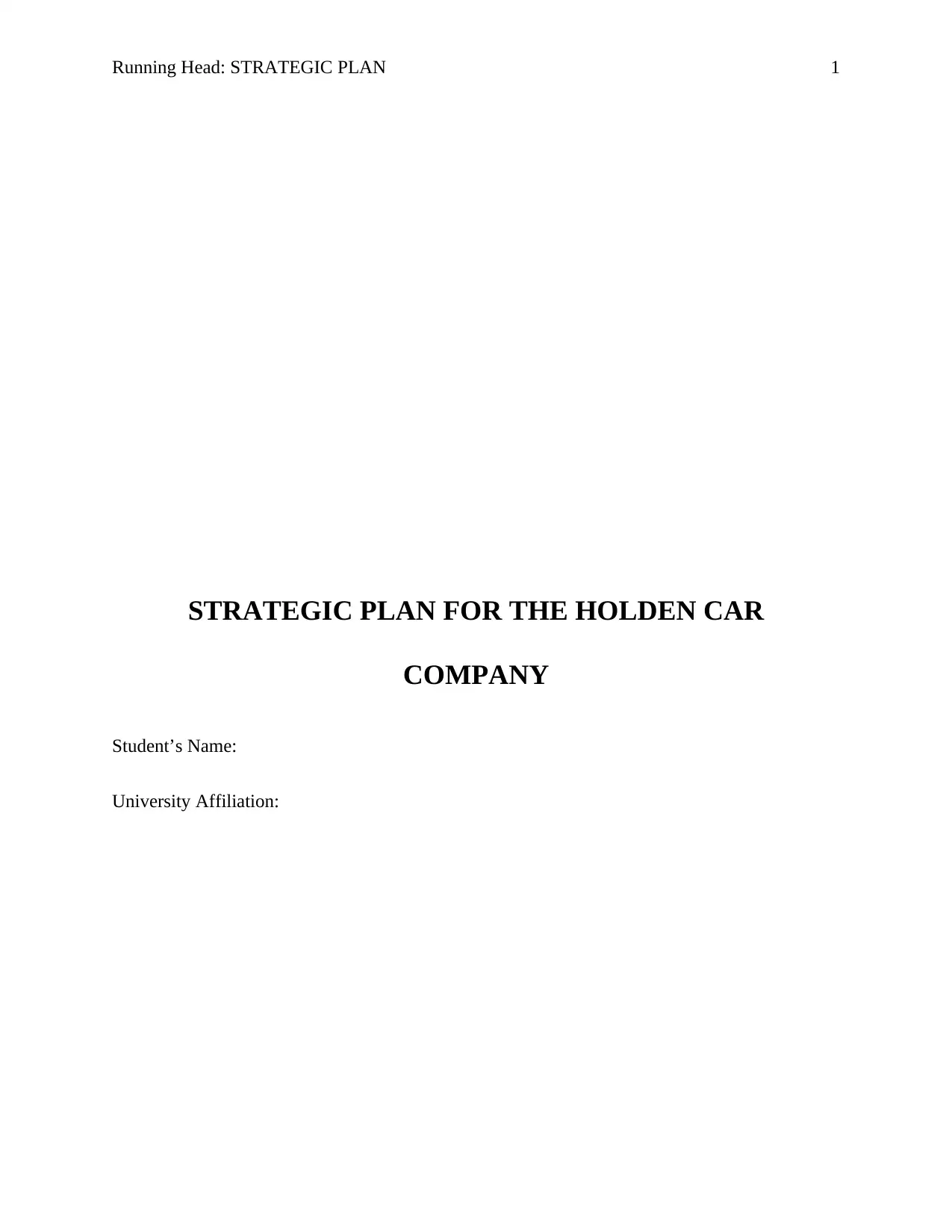
Running Head: STRATEGIC PLAN 1
STRATEGIC PLAN FOR THE HOLDEN CAR
COMPANY
Student’s Name:
University Affiliation:
STRATEGIC PLAN FOR THE HOLDEN CAR
COMPANY
Student’s Name:
University Affiliation:
Paraphrase This Document
Need a fresh take? Get an instant paraphrase of this document with our AI Paraphraser
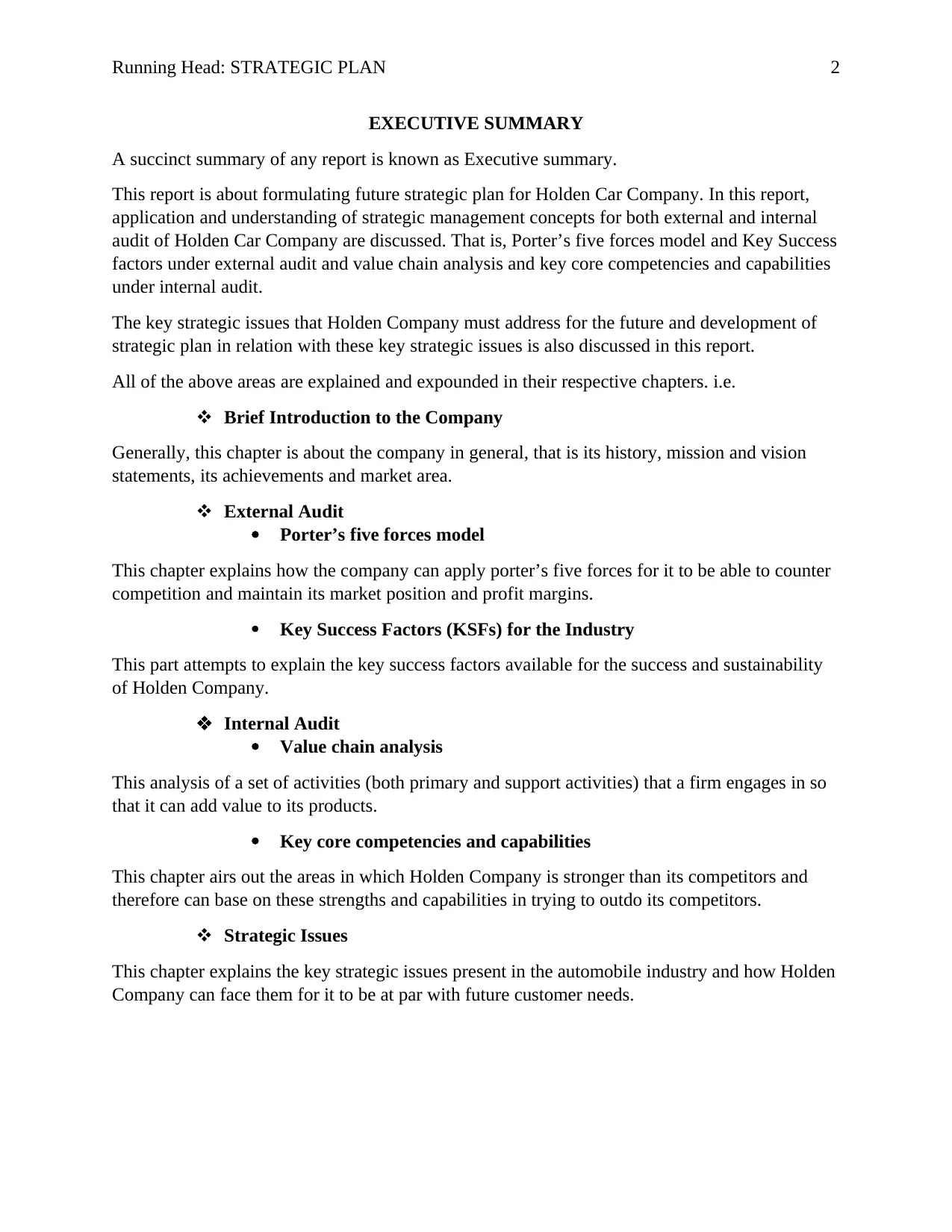
Running Head: STRATEGIC PLAN 2
EXECUTIVE SUMMARY
A succinct summary of any report is known as Executive summary.
This report is about formulating future strategic plan for Holden Car Company. In this report,
application and understanding of strategic management concepts for both external and internal
audit of Holden Car Company are discussed. That is, Porter’s five forces model and Key Success
factors under external audit and value chain analysis and key core competencies and capabilities
under internal audit.
The key strategic issues that Holden Company must address for the future and development of
strategic plan in relation with these key strategic issues is also discussed in this report.
All of the above areas are explained and expounded in their respective chapters. i.e.
Brief Introduction to the Company
Generally, this chapter is about the company in general, that is its history, mission and vision
statements, its achievements and market area.
External Audit
Porter’s five forces model
This chapter explains how the company can apply porter’s five forces for it to be able to counter
competition and maintain its market position and profit margins.
Key Success Factors (KSFs) for the Industry
This part attempts to explain the key success factors available for the success and sustainability
of Holden Company.
Internal Audit
Value chain analysis
This analysis of a set of activities (both primary and support activities) that a firm engages in so
that it can add value to its products.
Key core competencies and capabilities
This chapter airs out the areas in which Holden Company is stronger than its competitors and
therefore can base on these strengths and capabilities in trying to outdo its competitors.
Strategic Issues
This chapter explains the key strategic issues present in the automobile industry and how Holden
Company can face them for it to be at par with future customer needs.
EXECUTIVE SUMMARY
A succinct summary of any report is known as Executive summary.
This report is about formulating future strategic plan for Holden Car Company. In this report,
application and understanding of strategic management concepts for both external and internal
audit of Holden Car Company are discussed. That is, Porter’s five forces model and Key Success
factors under external audit and value chain analysis and key core competencies and capabilities
under internal audit.
The key strategic issues that Holden Company must address for the future and development of
strategic plan in relation with these key strategic issues is also discussed in this report.
All of the above areas are explained and expounded in their respective chapters. i.e.
Brief Introduction to the Company
Generally, this chapter is about the company in general, that is its history, mission and vision
statements, its achievements and market area.
External Audit
Porter’s five forces model
This chapter explains how the company can apply porter’s five forces for it to be able to counter
competition and maintain its market position and profit margins.
Key Success Factors (KSFs) for the Industry
This part attempts to explain the key success factors available for the success and sustainability
of Holden Company.
Internal Audit
Value chain analysis
This analysis of a set of activities (both primary and support activities) that a firm engages in so
that it can add value to its products.
Key core competencies and capabilities
This chapter airs out the areas in which Holden Company is stronger than its competitors and
therefore can base on these strengths and capabilities in trying to outdo its competitors.
Strategic Issues
This chapter explains the key strategic issues present in the automobile industry and how Holden
Company can face them for it to be at par with future customer needs.
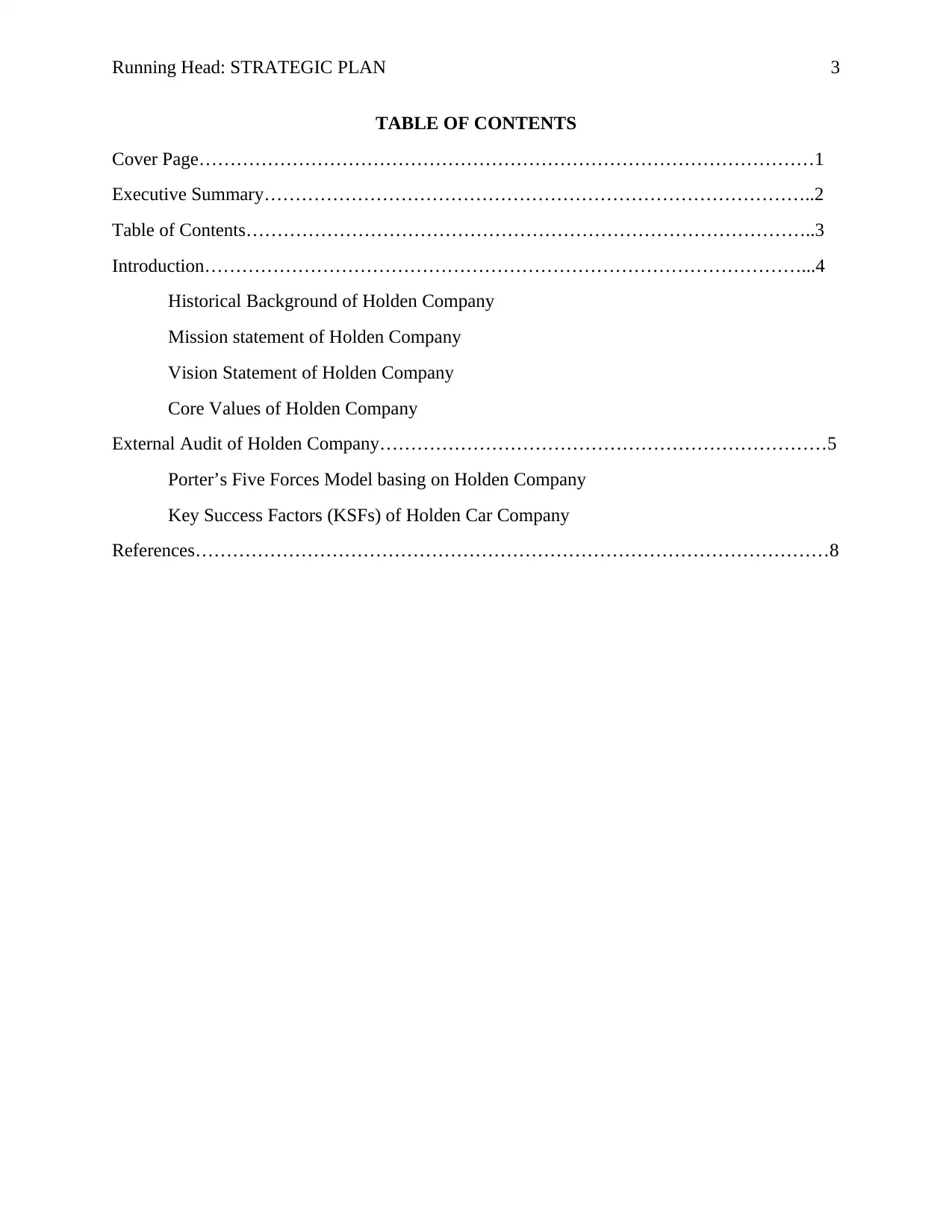
Running Head: STRATEGIC PLAN 3
TABLE OF CONTENTS
Cover Page………………………………………………………………………………………1
Executive Summary……………………………………………………………………………..2
Table of Contents………………………………………………………………………………..3
Introduction……………………………………………………………………………………...4
Historical Background of Holden Company
Mission statement of Holden Company
Vision Statement of Holden Company
Core Values of Holden Company
External Audit of Holden Company………………………………………………………………5
Porter’s Five Forces Model basing on Holden Company
Key Success Factors (KSFs) of Holden Car Company
References…………………………………………………………………………………………8
TABLE OF CONTENTS
Cover Page………………………………………………………………………………………1
Executive Summary……………………………………………………………………………..2
Table of Contents………………………………………………………………………………..3
Introduction……………………………………………………………………………………...4
Historical Background of Holden Company
Mission statement of Holden Company
Vision Statement of Holden Company
Core Values of Holden Company
External Audit of Holden Company………………………………………………………………5
Porter’s Five Forces Model basing on Holden Company
Key Success Factors (KSFs) of Holden Car Company
References…………………………………………………………………………………………8
⊘ This is a preview!⊘
Do you want full access?
Subscribe today to unlock all pages.

Trusted by 1+ million students worldwide
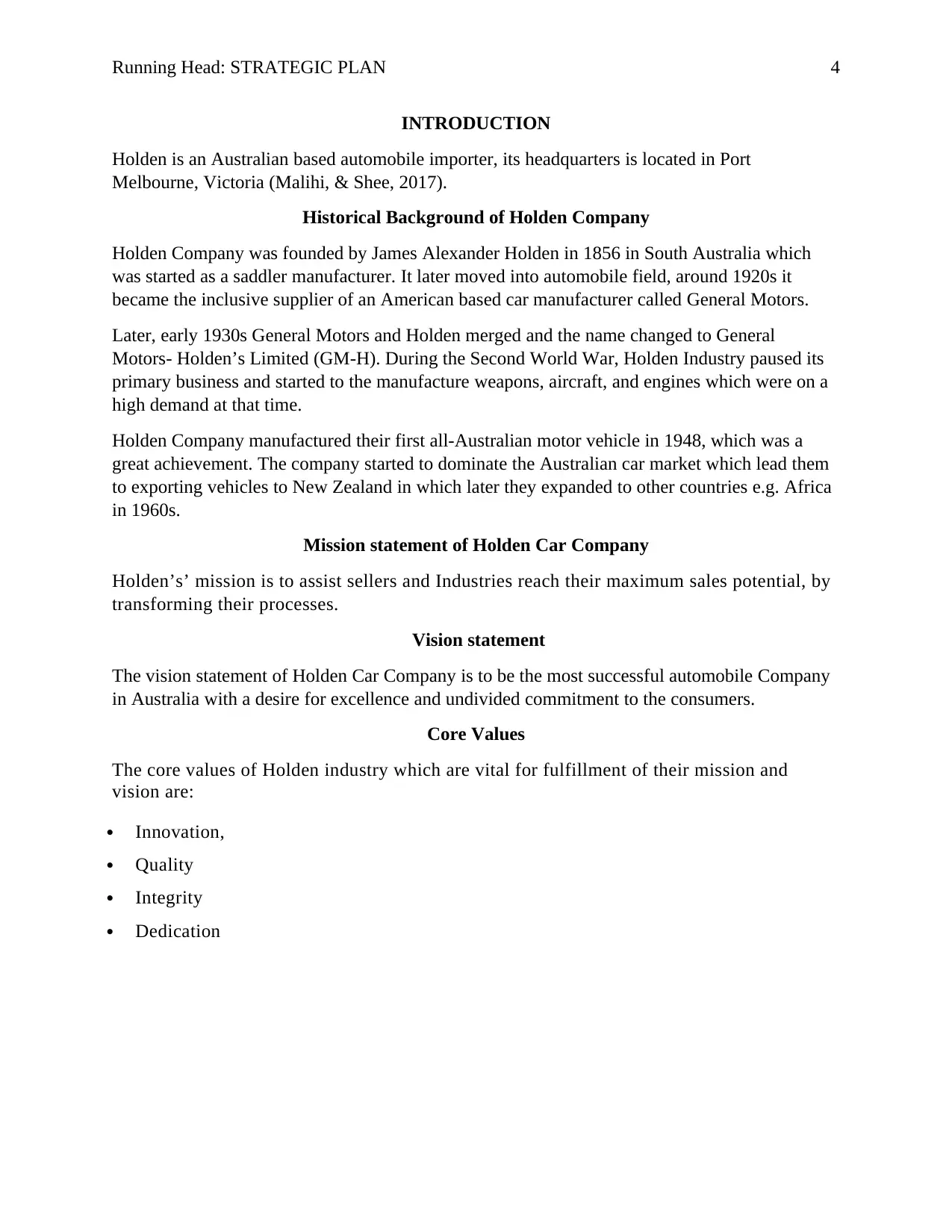
Running Head: STRATEGIC PLAN 4
INTRODUCTION
Holden is an Australian based automobile importer, its headquarters is located in Port
Melbourne, Victoria (Malihi, & Shee, 2017).
Historical Background of Holden Company
Holden Company was founded by James Alexander Holden in 1856 in South Australia which
was started as a saddler manufacturer. It later moved into automobile field, around 1920s it
became the inclusive supplier of an American based car manufacturer called General Motors.
Later, early 1930s General Motors and Holden merged and the name changed to General
Motors- Holden’s Limited (GM-H). During the Second World War, Holden Industry paused its
primary business and started to the manufacture weapons, aircraft, and engines which were on a
high demand at that time.
Holden Company manufactured their first all-Australian motor vehicle in 1948, which was a
great achievement. The company started to dominate the Australian car market which lead them
to exporting vehicles to New Zealand in which later they expanded to other countries e.g. Africa
in 1960s.
Mission statement of Holden Car Company
Holden’s’ mission is to assist sellers and Industries reach their maximum sales potential, by
transforming their processes.
Vision statement
The vision statement of Holden Car Company is to be the most successful automobile Company
in Australia with a desire for excellence and undivided commitment to the consumers.
Core Values
The core values of Holden industry which are vital for fulfillment of their mission and
vision are:
Innovation,
Quality
Integrity
Dedication
INTRODUCTION
Holden is an Australian based automobile importer, its headquarters is located in Port
Melbourne, Victoria (Malihi, & Shee, 2017).
Historical Background of Holden Company
Holden Company was founded by James Alexander Holden in 1856 in South Australia which
was started as a saddler manufacturer. It later moved into automobile field, around 1920s it
became the inclusive supplier of an American based car manufacturer called General Motors.
Later, early 1930s General Motors and Holden merged and the name changed to General
Motors- Holden’s Limited (GM-H). During the Second World War, Holden Industry paused its
primary business and started to the manufacture weapons, aircraft, and engines which were on a
high demand at that time.
Holden Company manufactured their first all-Australian motor vehicle in 1948, which was a
great achievement. The company started to dominate the Australian car market which lead them
to exporting vehicles to New Zealand in which later they expanded to other countries e.g. Africa
in 1960s.
Mission statement of Holden Car Company
Holden’s’ mission is to assist sellers and Industries reach their maximum sales potential, by
transforming their processes.
Vision statement
The vision statement of Holden Car Company is to be the most successful automobile Company
in Australia with a desire for excellence and undivided commitment to the consumers.
Core Values
The core values of Holden industry which are vital for fulfillment of their mission and
vision are:
Innovation,
Quality
Integrity
Dedication
Paraphrase This Document
Need a fresh take? Get an instant paraphrase of this document with our AI Paraphraser
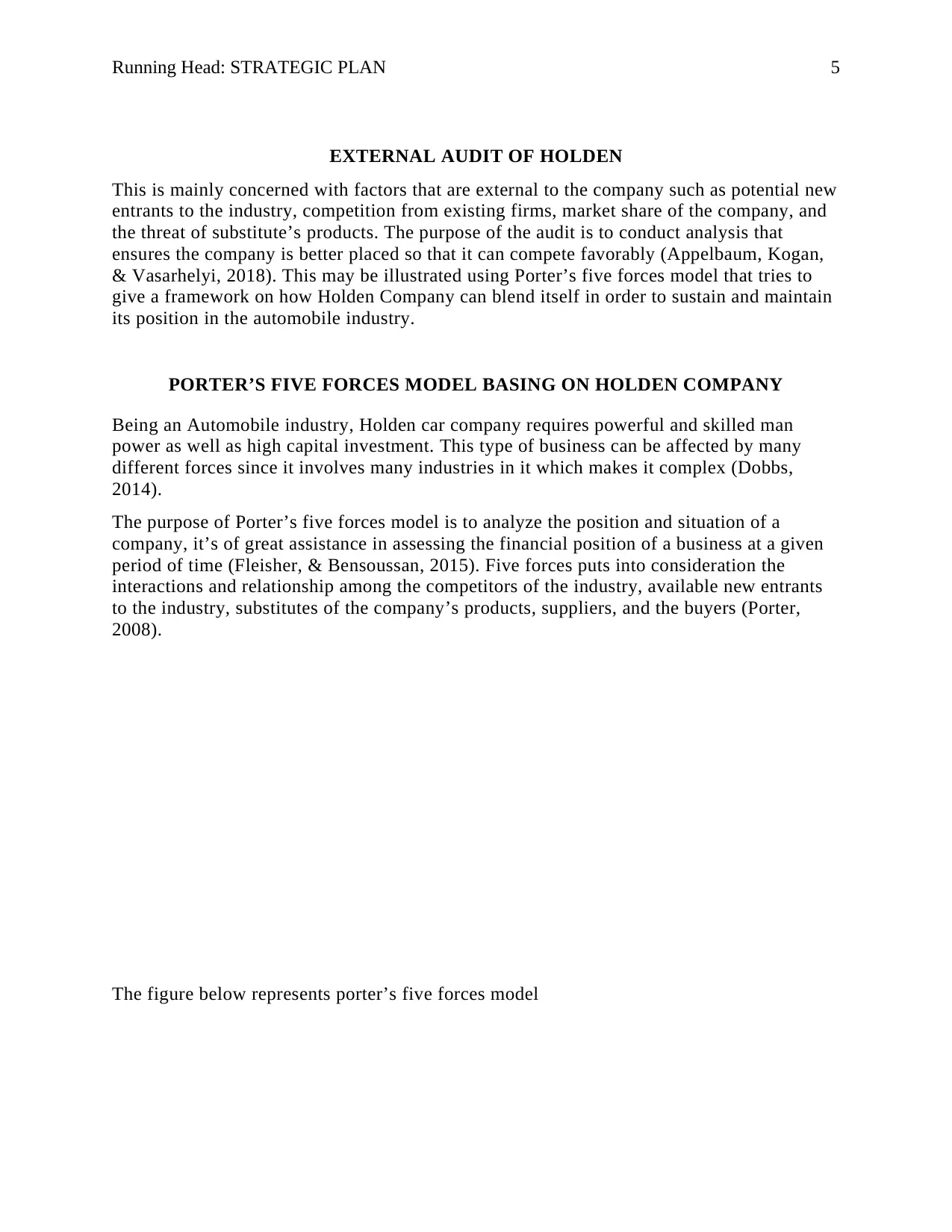
Running Head: STRATEGIC PLAN 5
EXTERNAL AUDIT OF HOLDEN
This is mainly concerned with factors that are external to the company such as potential new
entrants to the industry, competition from existing firms, market share of the company, and
the threat of substitute’s products. The purpose of the audit is to conduct analysis that
ensures the company is better placed so that it can compete favorably (Appelbaum, Kogan,
& Vasarhelyi, 2018). This may be illustrated using Porter’s five forces model that tries to
give a framework on how Holden Company can blend itself in order to sustain and maintain
its position in the automobile industry.
PORTER’S FIVE FORCES MODEL BASING ON HOLDEN COMPANY
Being an Automobile industry, Holden car company requires powerful and skilled man
power as well as high capital investment. This type of business can be affected by many
different forces since it involves many industries in it which makes it complex (Dobbs,
2014).
The purpose of Porter’s five forces model is to analyze the position and situation of a
company, it’s of great assistance in assessing the financial position of a business at a given
period of time (Fleisher, & Bensoussan, 2015). Five forces puts into consideration the
interactions and relationship among the competitors of the industry, available new entrants
to the industry, substitutes of the company’s products, suppliers, and the buyers (Porter,
2008).
The figure below represents porter’s five forces model
EXTERNAL AUDIT OF HOLDEN
This is mainly concerned with factors that are external to the company such as potential new
entrants to the industry, competition from existing firms, market share of the company, and
the threat of substitute’s products. The purpose of the audit is to conduct analysis that
ensures the company is better placed so that it can compete favorably (Appelbaum, Kogan,
& Vasarhelyi, 2018). This may be illustrated using Porter’s five forces model that tries to
give a framework on how Holden Company can blend itself in order to sustain and maintain
its position in the automobile industry.
PORTER’S FIVE FORCES MODEL BASING ON HOLDEN COMPANY
Being an Automobile industry, Holden car company requires powerful and skilled man
power as well as high capital investment. This type of business can be affected by many
different forces since it involves many industries in it which makes it complex (Dobbs,
2014).
The purpose of Porter’s five forces model is to analyze the position and situation of a
company, it’s of great assistance in assessing the financial position of a business at a given
period of time (Fleisher, & Bensoussan, 2015). Five forces puts into consideration the
interactions and relationship among the competitors of the industry, available new entrants
to the industry, substitutes of the company’s products, suppliers, and the buyers (Porter,
2008).
The figure below represents porter’s five forces model
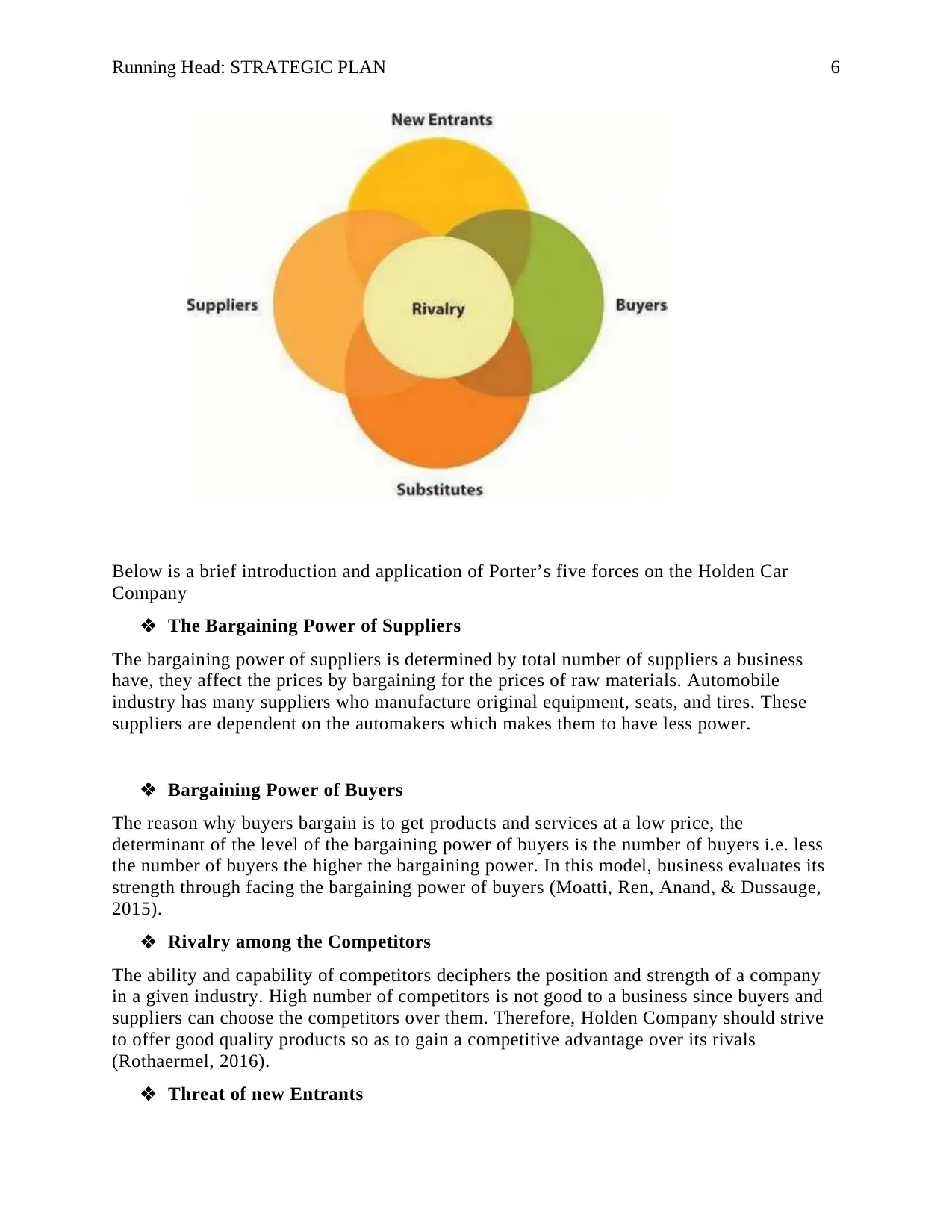
Running Head: STRATEGIC PLAN 6
Below is a brief introduction and application of Porter’s five forces on the Holden Car
Company
The Bargaining Power of Suppliers
The bargaining power of suppliers is determined by total number of suppliers a business
have, they affect the prices by bargaining for the prices of raw materials. Automobile
industry has many suppliers who manufacture original equipment, seats, and tires. These
suppliers are dependent on the automakers which makes them to have less power.
Bargaining Power of Buyers
The reason why buyers bargain is to get products and services at a low price, the
determinant of the level of the bargaining power of buyers is the number of buyers i.e. less
the number of buyers the higher the bargaining power. In this model, business evaluates its
strength through facing the bargaining power of buyers (Moatti, Ren, Anand, & Dussauge,
2015).
Rivalry among the Competitors
The ability and capability of competitors deciphers the position and strength of a company
in a given industry. High number of competitors is not good to a business since buyers and
suppliers can choose the competitors over them. Therefore, Holden Company should strive
to offer good quality products so as to gain a competitive advantage over its rivals
(Rothaermel, 2016).
Threat of new Entrants
Below is a brief introduction and application of Porter’s five forces on the Holden Car
Company
The Bargaining Power of Suppliers
The bargaining power of suppliers is determined by total number of suppliers a business
have, they affect the prices by bargaining for the prices of raw materials. Automobile
industry has many suppliers who manufacture original equipment, seats, and tires. These
suppliers are dependent on the automakers which makes them to have less power.
Bargaining Power of Buyers
The reason why buyers bargain is to get products and services at a low price, the
determinant of the level of the bargaining power of buyers is the number of buyers i.e. less
the number of buyers the higher the bargaining power. In this model, business evaluates its
strength through facing the bargaining power of buyers (Moatti, Ren, Anand, & Dussauge,
2015).
Rivalry among the Competitors
The ability and capability of competitors deciphers the position and strength of a company
in a given industry. High number of competitors is not good to a business since buyers and
suppliers can choose the competitors over them. Therefore, Holden Company should strive
to offer good quality products so as to gain a competitive advantage over its rivals
(Rothaermel, 2016).
Threat of new Entrants
⊘ This is a preview!⊘
Do you want full access?
Subscribe today to unlock all pages.

Trusted by 1+ million students worldwide
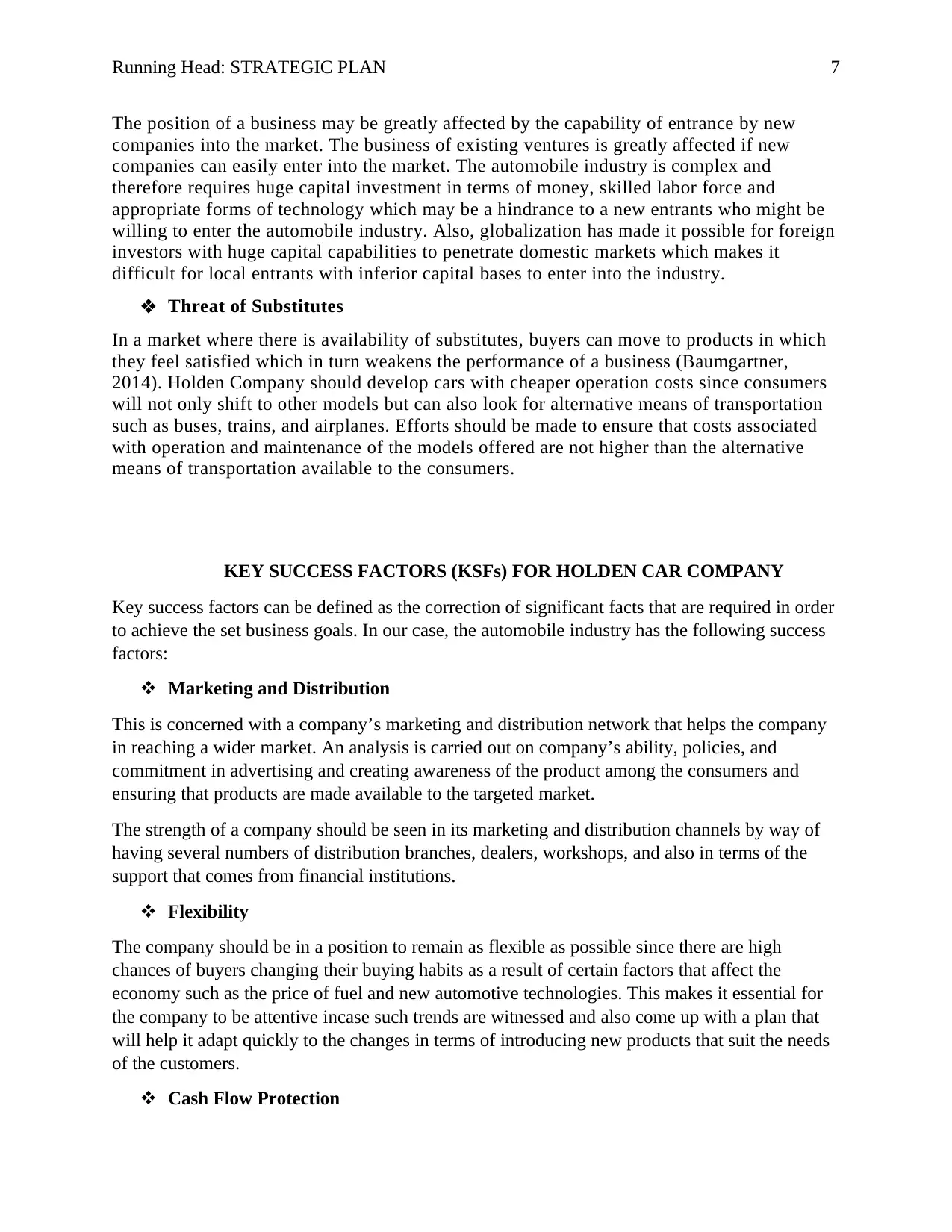
Running Head: STRATEGIC PLAN 7
The position of a business may be greatly affected by the capability of entrance by new
companies into the market. The business of existing ventures is greatly affected if new
companies can easily enter into the market. The automobile industry is complex and
therefore requires huge capital investment in terms of money, skilled labor force and
appropriate forms of technology which may be a hindrance to a new entrants who might be
willing to enter the automobile industry. Also, globalization has made it possible for foreign
investors with huge capital capabilities to penetrate domestic markets which makes it
difficult for local entrants with inferior capital bases to enter into the industry.
Threat of Substitutes
In a market where there is availability of substitutes, buyers can move to products in which
they feel satisfied which in turn weakens the performance of a business (Baumgartner,
2014). Holden Company should develop cars with cheaper operation costs since consumers
will not only shift to other models but can also look for alternative means of transportation
such as buses, trains, and airplanes. Efforts should be made to ensure that costs associated
with operation and maintenance of the models offered are not higher than the alternative
means of transportation available to the consumers.
KEY SUCCESS FACTORS (KSFs) FOR HOLDEN CAR COMPANY
Key success factors can be defined as the correction of significant facts that are required in order
to achieve the set business goals. In our case, the automobile industry has the following success
factors:
Marketing and Distribution
This is concerned with a company’s marketing and distribution network that helps the company
in reaching a wider market. An analysis is carried out on company’s ability, policies, and
commitment in advertising and creating awareness of the product among the consumers and
ensuring that products are made available to the targeted market.
The strength of a company should be seen in its marketing and distribution channels by way of
having several numbers of distribution branches, dealers, workshops, and also in terms of the
support that comes from financial institutions.
Flexibility
The company should be in a position to remain as flexible as possible since there are high
chances of buyers changing their buying habits as a result of certain factors that affect the
economy such as the price of fuel and new automotive technologies. This makes it essential for
the company to be attentive incase such trends are witnessed and also come up with a plan that
will help it adapt quickly to the changes in terms of introducing new products that suit the needs
of the customers.
Cash Flow Protection
The position of a business may be greatly affected by the capability of entrance by new
companies into the market. The business of existing ventures is greatly affected if new
companies can easily enter into the market. The automobile industry is complex and
therefore requires huge capital investment in terms of money, skilled labor force and
appropriate forms of technology which may be a hindrance to a new entrants who might be
willing to enter the automobile industry. Also, globalization has made it possible for foreign
investors with huge capital capabilities to penetrate domestic markets which makes it
difficult for local entrants with inferior capital bases to enter into the industry.
Threat of Substitutes
In a market where there is availability of substitutes, buyers can move to products in which
they feel satisfied which in turn weakens the performance of a business (Baumgartner,
2014). Holden Company should develop cars with cheaper operation costs since consumers
will not only shift to other models but can also look for alternative means of transportation
such as buses, trains, and airplanes. Efforts should be made to ensure that costs associated
with operation and maintenance of the models offered are not higher than the alternative
means of transportation available to the consumers.
KEY SUCCESS FACTORS (KSFs) FOR HOLDEN CAR COMPANY
Key success factors can be defined as the correction of significant facts that are required in order
to achieve the set business goals. In our case, the automobile industry has the following success
factors:
Marketing and Distribution
This is concerned with a company’s marketing and distribution network that helps the company
in reaching a wider market. An analysis is carried out on company’s ability, policies, and
commitment in advertising and creating awareness of the product among the consumers and
ensuring that products are made available to the targeted market.
The strength of a company should be seen in its marketing and distribution channels by way of
having several numbers of distribution branches, dealers, workshops, and also in terms of the
support that comes from financial institutions.
Flexibility
The company should be in a position to remain as flexible as possible since there are high
chances of buyers changing their buying habits as a result of certain factors that affect the
economy such as the price of fuel and new automotive technologies. This makes it essential for
the company to be attentive incase such trends are witnessed and also come up with a plan that
will help it adapt quickly to the changes in terms of introducing new products that suit the needs
of the customers.
Cash Flow Protection
Paraphrase This Document
Need a fresh take? Get an instant paraphrase of this document with our AI Paraphraser
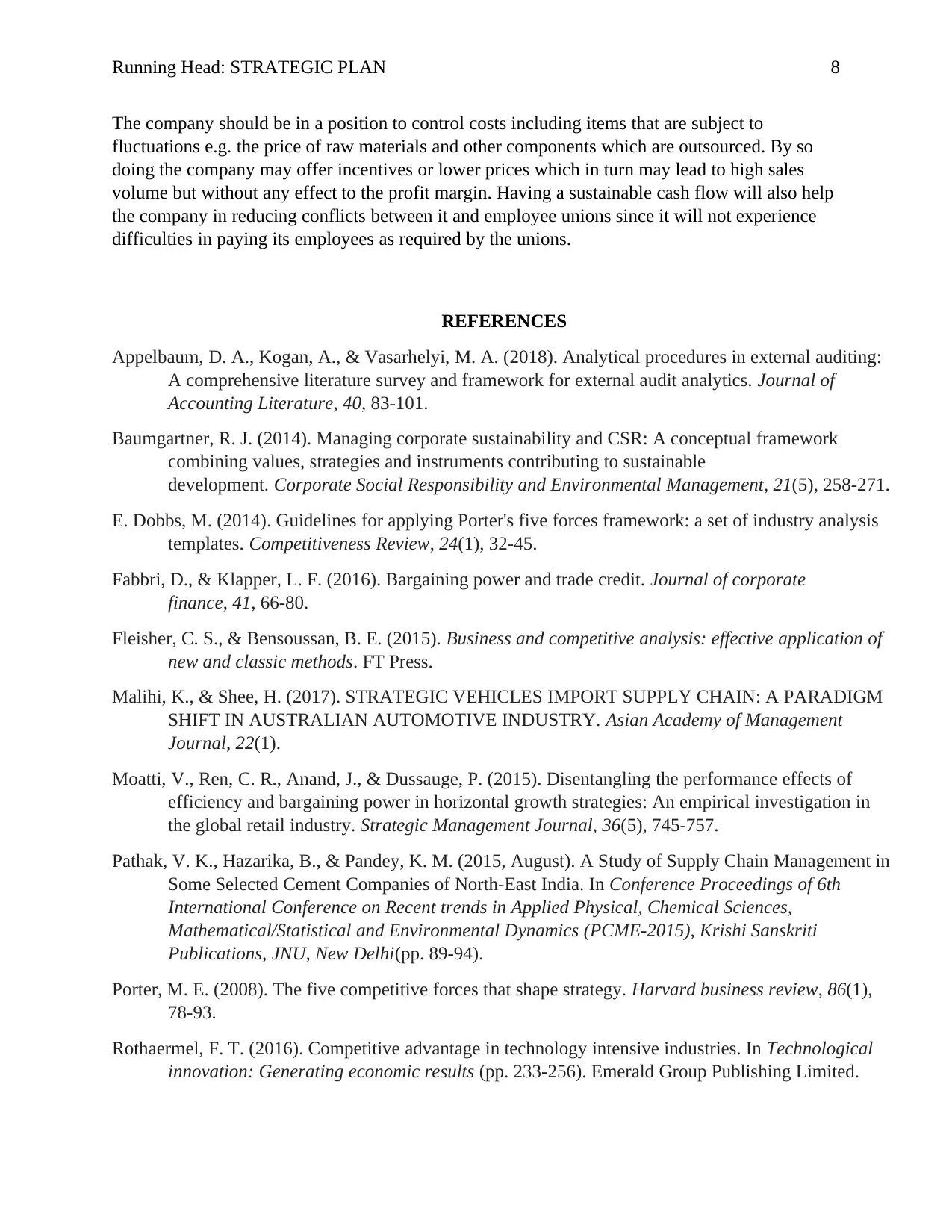
Running Head: STRATEGIC PLAN 8
The company should be in a position to control costs including items that are subject to
fluctuations e.g. the price of raw materials and other components which are outsourced. By so
doing the company may offer incentives or lower prices which in turn may lead to high sales
volume but without any effect to the profit margin. Having a sustainable cash flow will also help
the company in reducing conflicts between it and employee unions since it will not experience
difficulties in paying its employees as required by the unions.
REFERENCES
Appelbaum, D. A., Kogan, A., & Vasarhelyi, M. A. (2018). Analytical procedures in external auditing:
A comprehensive literature survey and framework for external audit analytics. Journal of
Accounting Literature, 40, 83-101.
Baumgartner, R. J. (2014). Managing corporate sustainability and CSR: A conceptual framework
combining values, strategies and instruments contributing to sustainable
development. Corporate Social Responsibility and Environmental Management, 21(5), 258-271.
E. Dobbs, M. (2014). Guidelines for applying Porter's five forces framework: a set of industry analysis
templates. Competitiveness Review, 24(1), 32-45.
Fabbri, D., & Klapper, L. F. (2016). Bargaining power and trade credit. Journal of corporate
finance, 41, 66-80.
Fleisher, C. S., & Bensoussan, B. E. (2015). Business and competitive analysis: effective application of
new and classic methods. FT Press.
Malihi, K., & Shee, H. (2017). STRATEGIC VEHICLES IMPORT SUPPLY CHAIN: A PARADIGM
SHIFT IN AUSTRALIAN AUTOMOTIVE INDUSTRY. Asian Academy of Management
Journal, 22(1).
Moatti, V., Ren, C. R., Anand, J., & Dussauge, P. (2015). Disentangling the performance effects of
efficiency and bargaining power in horizontal growth strategies: An empirical investigation in
the global retail industry. Strategic Management Journal, 36(5), 745-757.
Pathak, V. K., Hazarika, B., & Pandey, K. M. (2015, August). A Study of Supply Chain Management in
Some Selected Cement Companies of North-East India. In Conference Proceedings of 6th
International Conference on Recent trends in Applied Physical, Chemical Sciences,
Mathematical/Statistical and Environmental Dynamics (PCME-2015), Krishi Sanskriti
Publications, JNU, New Delhi(pp. 89-94).
Porter, M. E. (2008). The five competitive forces that shape strategy. Harvard business review, 86(1),
78-93.
Rothaermel, F. T. (2016). Competitive advantage in technology intensive industries. In Technological
innovation: Generating economic results (pp. 233-256). Emerald Group Publishing Limited.
The company should be in a position to control costs including items that are subject to
fluctuations e.g. the price of raw materials and other components which are outsourced. By so
doing the company may offer incentives or lower prices which in turn may lead to high sales
volume but without any effect to the profit margin. Having a sustainable cash flow will also help
the company in reducing conflicts between it and employee unions since it will not experience
difficulties in paying its employees as required by the unions.
REFERENCES
Appelbaum, D. A., Kogan, A., & Vasarhelyi, M. A. (2018). Analytical procedures in external auditing:
A comprehensive literature survey and framework for external audit analytics. Journal of
Accounting Literature, 40, 83-101.
Baumgartner, R. J. (2014). Managing corporate sustainability and CSR: A conceptual framework
combining values, strategies and instruments contributing to sustainable
development. Corporate Social Responsibility and Environmental Management, 21(5), 258-271.
E. Dobbs, M. (2014). Guidelines for applying Porter's five forces framework: a set of industry analysis
templates. Competitiveness Review, 24(1), 32-45.
Fabbri, D., & Klapper, L. F. (2016). Bargaining power and trade credit. Journal of corporate
finance, 41, 66-80.
Fleisher, C. S., & Bensoussan, B. E. (2015). Business and competitive analysis: effective application of
new and classic methods. FT Press.
Malihi, K., & Shee, H. (2017). STRATEGIC VEHICLES IMPORT SUPPLY CHAIN: A PARADIGM
SHIFT IN AUSTRALIAN AUTOMOTIVE INDUSTRY. Asian Academy of Management
Journal, 22(1).
Moatti, V., Ren, C. R., Anand, J., & Dussauge, P. (2015). Disentangling the performance effects of
efficiency and bargaining power in horizontal growth strategies: An empirical investigation in
the global retail industry. Strategic Management Journal, 36(5), 745-757.
Pathak, V. K., Hazarika, B., & Pandey, K. M. (2015, August). A Study of Supply Chain Management in
Some Selected Cement Companies of North-East India. In Conference Proceedings of 6th
International Conference on Recent trends in Applied Physical, Chemical Sciences,
Mathematical/Statistical and Environmental Dynamics (PCME-2015), Krishi Sanskriti
Publications, JNU, New Delhi(pp. 89-94).
Porter, M. E. (2008). The five competitive forces that shape strategy. Harvard business review, 86(1),
78-93.
Rothaermel, F. T. (2016). Competitive advantage in technology intensive industries. In Technological
innovation: Generating economic results (pp. 233-256). Emerald Group Publishing Limited.
1 out of 8
Related Documents
Your All-in-One AI-Powered Toolkit for Academic Success.
+13062052269
info@desklib.com
Available 24*7 on WhatsApp / Email
![[object Object]](/_next/static/media/star-bottom.7253800d.svg)
Unlock your academic potential
Copyright © 2020–2025 A2Z Services. All Rights Reserved. Developed and managed by ZUCOL.





